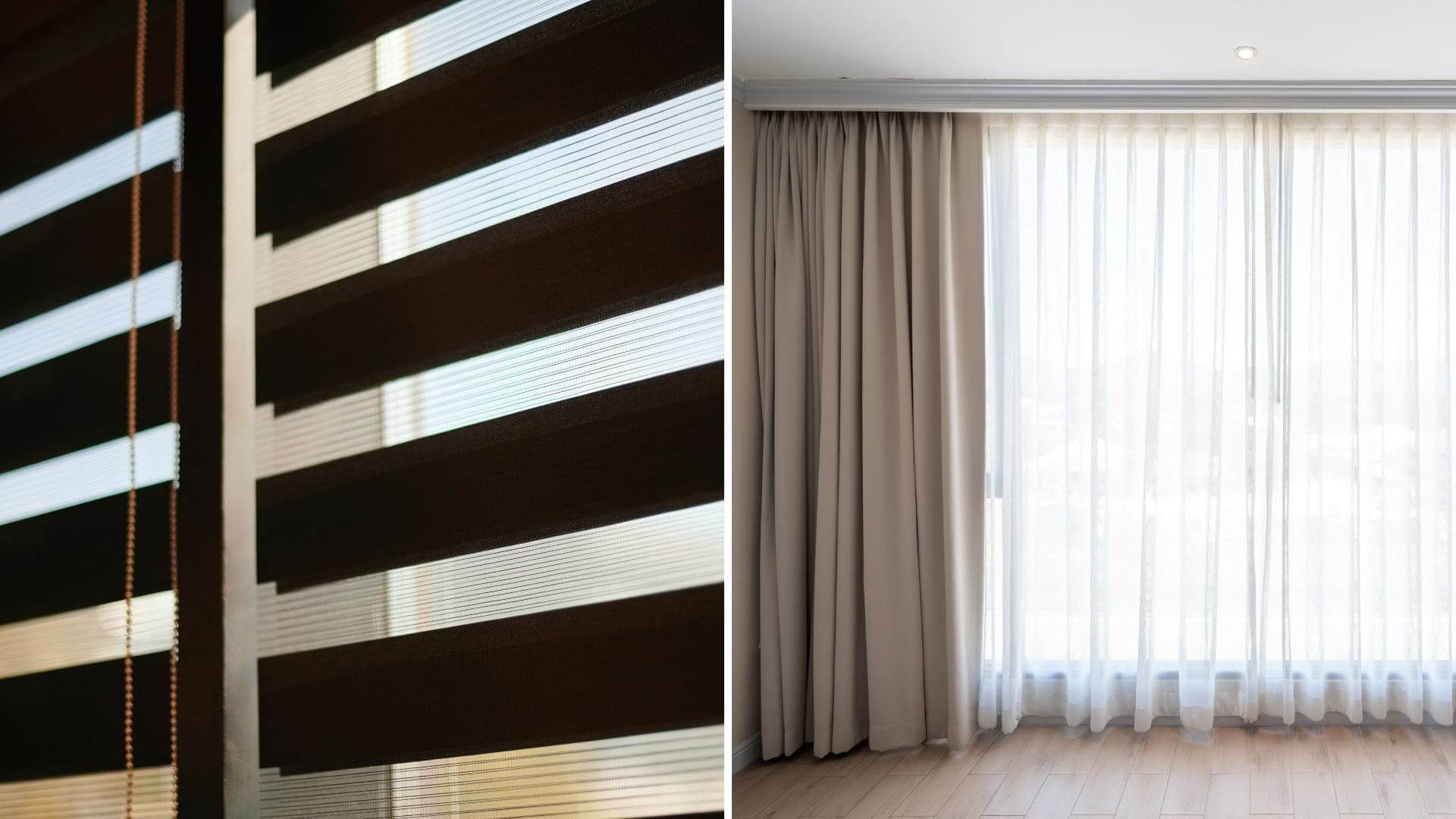Both blinds and curtains can really transform your home into a cozy space, just by adding a personal touch and character. It drastically enhances the ambiance and style of the living area while also providing protection and shade from sunlight, a screen for air pollutants, and privacy for your home.
People frequently wonder which is better—curtains or blinds— especially, when they want to mix and match styles that will look suitable to the rest of the furnishings in their home. The debate over blinds vs. curtains typically comes down to a matter of personal preference. But if you are still stuck choosing between the two, we come up with a perfect solution for you! So, before you decide on your bet, we will give you first an idea of the differences between the two, that you must consider!
Common Types of Window Treatments
A window treatment is a cover or adjustment of a window, generally done with the intention of improving the room’s and window‘s aesthetics.
Curtains
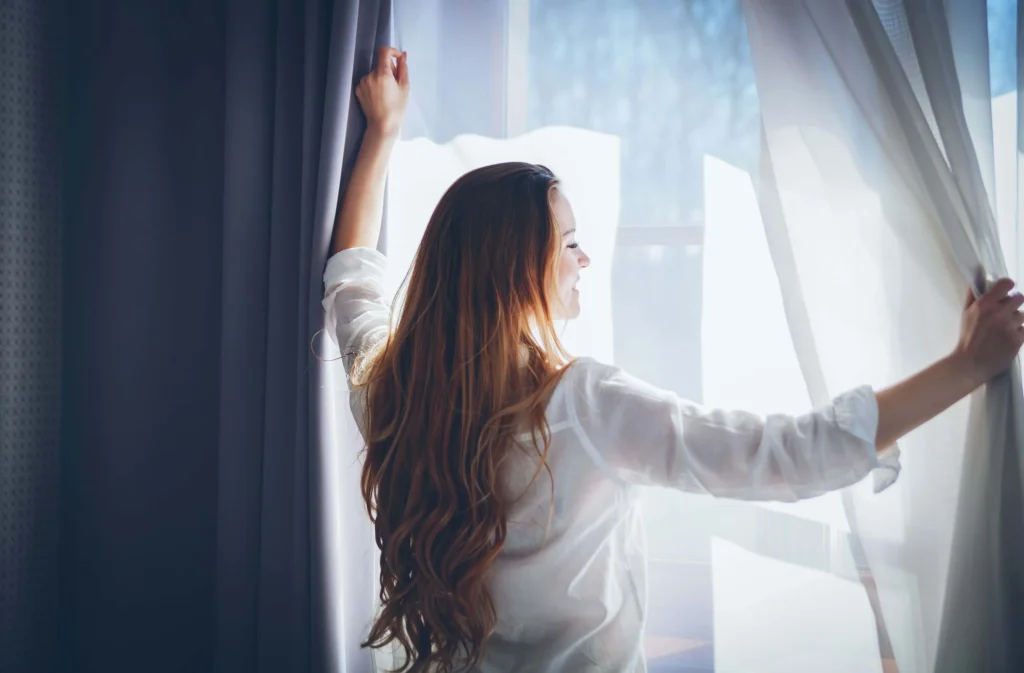
Drapery
A type of curtain that can be used to give your home a sophisticated, simple, or classy atmosphere. It can be drawn across the rod or stand still on one or both sides of the window. They are made specifically for the window in which they will be put. They are created from any material, including thicker or more opulent textiles, in any length and opacity.
Drapes or Drapery is a curtain that is made exactly how you wanted. It comes in a variety of designs, materials, sizes, tones, and patterns. They differ in terms of their capacity to be cleaned, how quickly they age in the presence of UV radiation, how well they retain dust and grease, how well they absorb sound, and how long they last. What’s amazing is it can also be manipulated manually, using wires, press-button pads, or by computers that are controlled remotely. Depending on what type of curtain you want, the size of the window, and the type and weight of the curtain, different curtain sizes are required for different windows.
Sheer Curtains (Net Curtains)
A sheer curtain, also known as the net curtain, is made of translucent fabric. The sheerness of fabric can be characterized in three ways: extremely rare, very thin, and barely visible. They are commonly referred to as privacy curtains since they block direct outside views while allowing you to see inside a room during the day.
The fabric that is used for sheer curtains is silk, rayon, nylon, and gossamer since these materials can be made translucent. Although the sheer fabric is available in a broad range of hues; white and its many variations, including cream, winter white, eggshell, and ivory, are the most common and preferred colors used for curtains.
Blinds
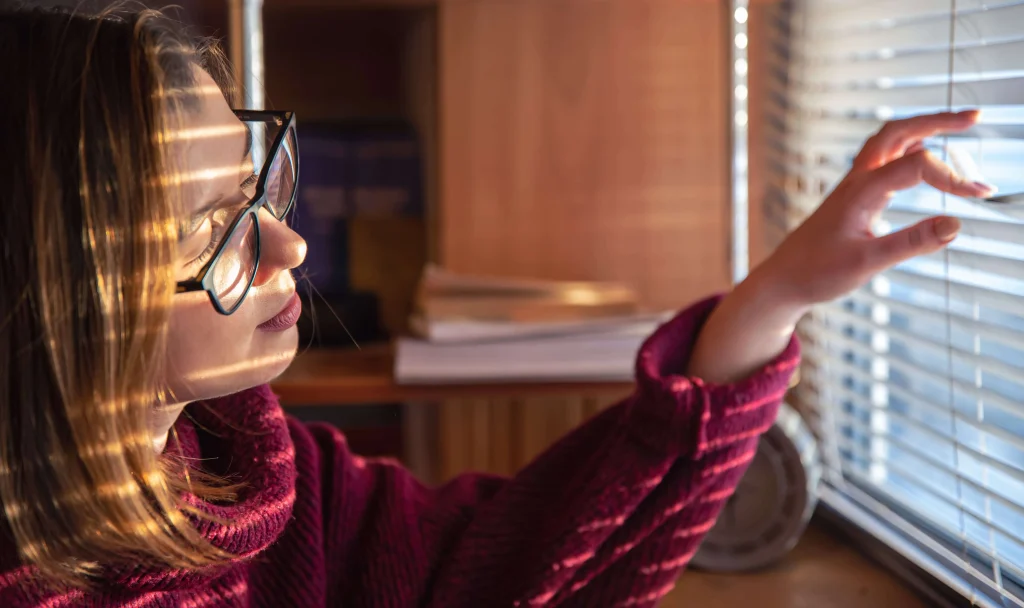
Pleated blinds
Pleated blinds are folding blinds that, depending on how much the folds are extended or compressed, can completely or partially cover the window. Pleated blinds have an adaptable control mechanism that allows them to be compressed either vertically or horizontally, towards one side or the other, or in the center.
Small to medium-sized windows are perfect for pleated blinds, which are also often used as roof coverings in conservatories.
Venetian Blinds
The Venetian Blinds are made of plastic, metal, or wood. They can be turned collectively through almost 180 degrees since they are supported by cords or by fabric strips called tapes. The slats may be turned in two directions, one in which they overlap with one side looking inward and the other in which they overlap with the opposite side facing inside. By adjusting the rotation, it is possible to get different levels of spacing between the slats between those two ends. Slat width ranges from 16 to 120 mm, with 25 mm being the most preferred width.
Vertical Blinds
Vertical blinds, as opposed to horizontal ones, are less prone to gather dust because of the way they are mounted. They work better on doors and windows that also glide side to side because they pull to the side rather than raising and lowering. In general, they work more quickly and with less physical effort. They are a great option for covering both patio doors and extraordinarily broad windows. Fabric panels will provide insulation from the sun’s heat and the wind’s cold. They also reduce noise.
Vertical blinds come in flat plastic (PVC), fabric, embossed PVC, imitation wood, metal, wood, and S-curved slats, among other materials. Additionally, vertical blinds are installed above doors in public places to preserve the heat within the space and/or to deter flies and other insects from entering the structure in warmer climes.
Roller Blinds
Window blinds are constructed of a flat sheet of cloth that may be rolled up to allow you to look out the window.
Roller shades, also known as roll-up shades or roller blinds, are a simple and cost-effective method to add color, flair, and texture to any room. Built with modern materials and basic functionality for convenience of usage.
Types of Curtain Rods and What Is Best for Your Home!
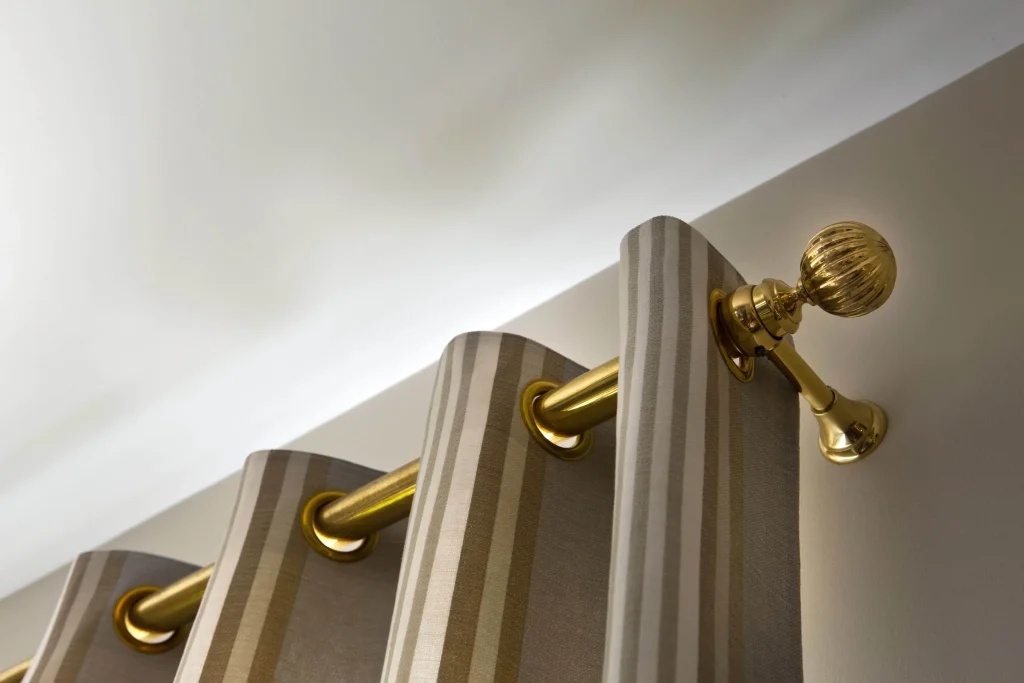
Decorative Curtain Rod
A decorative single curtain rod comes in a variety of designs, sizes, and finishes and is an excellent way to add a sophisticated look to your windows. This style of rod is frequently extensible to accommodate various types of window sizes, and typical materials include wood, brass, iron, or brushed nickel. The wood inlay on either end of the rod, which comes in a variety of forms and sizes, from sleek, minimalist ones to more ornate and vintage-style ones, and even kids’ themed ones, are what set it apart. They are easily detachable and screwed onto the ends of the rod. Their primary function is to hold the curtain panels in place, but they also assist to dress up the windows and offer a nice accent.
These are best to use in any window in your home as well as sliding doors. It gives an elegant vibe and fits the contemporary design of Italian-inspired homes. Keep this in mind while you try to find a house and lot near Evia.
Tension Rod
A tension rod, sometimes known as a cafe curtain rod, varies from other common curtain rods in that it does not need to be permanently installed into a wall, ceiling, or window. This kind of rod is adjustable in length and maintains its position by snugly fitting between two walls, or in this example, each side of the window frame, much like a shower curtain rod you could use in a bathroom. Lightweight curtains used on tiny windows, such as traditional cafe curtains on the kitchen window, are ideally suited for tension rods. The rods are inexpensive compared to other more long-term choices and are simple to “install” and remove because they aren’t bolted into the wall.
This is best as hanging cafe curtains and other lightweight curtains on tiny windows.
Double Curtain Rod
A double curtain rod has a similar style to a traditional decorative rod, but it has two rods instead of one so you may overlay two different kinds of window coverings on one window. It has two rods, sometimes with the front one being thicker and more decorative. The biggest advantage of utilizing a double rod is that you may use thicker panels and sheer curtains simultaneously, which is extremely useful on bright sunny days and in the chilly winter months. This style of rod’s aesthetic advantage is that it adds depth and a more dramatic impact, particularly when strong or contrasting colors and patterns are employed.
If you have larger or double windows, this will be the best choice!
Traverse Curtain Rod
With a traverse curtain rod, the panel slides when the curtains are opened or closed thanks to an internal mechanism and built-in clips that link to loops on the back of your curtain panel. Depending on whether you want a single layer of panels or to layer two different curtain types together, this style of rod may be mounted on the wall or ceiling and is available in single or double designs. The rod is more concealed than a traditional single or double rod would be, making it a terrific method to achieve a sleek and modern appearance.
This type of rod is best for the bedroom.
Motorized Curtain Rod
A motorized curtain rod is the most modern variety available, and it could conjure images of a chic hotel with a modern design. Because of its elegant appearance and practicality, this kind of rod is growing in popularity among homeowners. The curtains are remote-controlled, allowing you to open and close them from the comfort of your couch or bed. Some higher-end models even include voice control. When looking for this kind of rod, keep in mind that it is also the most costly of all the rods and has weight restrictions.
This is suitable for living rooms and bedrooms.
Is It Better to Have Blinds or Curtains?
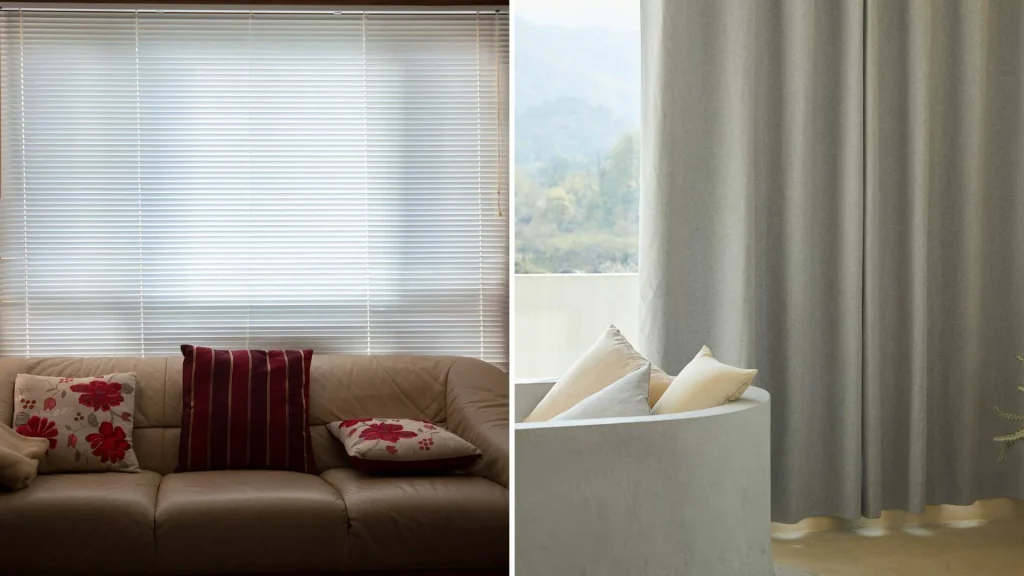
Advantages of Curtains
Privacy and Light Control
There is no set time during the day when curtains go up or down, which is a huge advantage over other window treatments like blinds. If a person is sensitive to light throughout the day, they can use window coverings like curtains or shades to block out the light and protect themselves from whatever time of day it may be.
Cleanliness
Curtains can frequently be cleaned by just washing them on a regular cycle with other clothes; this eliminates the need for pricey professional window cleaning services every few months when soap scum starts to cling to window panes like spiderwebs, which typically occurs more frequently because window blinds collect dust and pet hair that only accumulate over time.
Energy Savings
Curtains provide the benefit of making your home more energy efficient. It decreases heat and cold drafts by being installed on the inside of your windows, which lowers your heating and cooling costs.
Other Pros of Having Curtains:
- There are several colors and patterns available.
- A lot of textures are available
- Various thickness choices (eg. sheer curtains or thick, heavy, thermal-backed curtains)
- Smaller gaps can lead to significant energy savings.
- Depending on the necessity, affordable blinds may be obtained.
- Excellent for establishing a certain ambiance in home design.
- Blackout curtains are more effective in blocking out light.
Disadvantages of Curtains
Energy Savings
While curtains may help reduce heat from the sun and drafts, it’s crucial to think about the material you pick to provide a permanent covering. If your windows are not completely covered, a small amount of light and draft may enter. If you want to completely block off light, think about using window coverings like wooden shutters.
Installation Difficulties
Depending on the type of window you have, professional installation of the curtains may not always be possible. To ensure that your curtains are secured securely to support the weight, carefully examine the nearby buildings and fixture points.
Other Cons of Curtains:
- Not as long-lasting as blinders
- Made-to-order curtains are more costly than made-to-order blinds.
- Most are not appropriate for bathrooms or kitchens.
- Covering radiators might diminish energy savings.
- Light cannot be filtered in; it must be either open or closed.
- It is possible for it to get moldy, discolored, or moth-eaten.
- Cleaning curtains made it a little bit difficult.
Advantages of Blinds
Simple to use
Blinds for windows are quite simple to operate. Practically, no particular procedure is required to cover and remove the windows. Furthermore, some of the window coverings include remote controls and automated operation. A little child may operate the blinds by simply touching the designated button. These curtain systems are also extremely simple to install.
Comfort
The blinds do not sway to the beat of the fans like conventional curtains do. Even when the fan is running at full power, they hold tight and ensure total privacy.
Other Pros of Blinds:
- There are many different colors and patterns available.
- Various slat sizes and thicknesses are available (eg. lined Roman blinds)
- Can offer significant energy savings when mounted on the window.
- Less expensive than ready-made curtains
- Interior design that is cleaner and more simplistic
- Curtains are less durable.
- It may be utilized in every room of the house.
- Can act as a light filter
- Cleaner and easier to maintain
Disadvantages of Having Blinds
Not Appropriate for Every Style
Blinds and other window treatments don’t look good in traditional or antique buildings. Only thick fabric classic curtains will look well on traditional huge windows.
Quite Tough to Clean
Window blind cleaning is rather stressful and taxing. It seems like a huge time waster to have to clean them one at a time. While with typical curtains, you may wash the entire set in your washing machine with lukewarm soapy water.
Difficulty in Maintenance
The blinding system’s cables become tangled, making it hard to straighten them out again. The same holds true for models with remote functionality. You must take a little more care to keep blinds in functioning order.
Other Cons of Having Blinds:
- Not quite as effective at fully filtering out light.
- There aren’t as many textures available (but still a good range)
- Slat blinds aren’t as efficient as roller blinds (eg. Venetian, vertical)
Whether you are moving to your newly bought house and lot near Evia or deciding to upgrade the style of your home, make sure to visit the AllHome branch in Evia Lifestyle Center, Las Piñas. It is a one-stop shop that offers convenience with everything you need and will assist you in providing excellent home basics.
Read more: Where Should You Splurge or Save in Your Bedroom?


